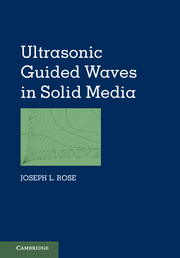Book contents
- Frontmatter
- Contents
- Nomenclature
- Preface
- Acknowledgments
- 1 Introduction
- 2 Dispersion Principles
- 3 Unbounded Isotropic and Anisotropic Media
- 4 Reflection and Refraction
- 5 Oblique Incidence
- 6 Waves in Plates
- 7 Surface and Subsurface Waves
- 8 Finite Element Method for Guided Wave Mechanics
- 9 The Semi-Analytical Finite Element Method
- 10 Guided Waves in Hollow Cylinders
- 11 Circumferential Guided Waves
- 12 Guided Waves in Layered Structures
- 13 Source Influence on Guided Wave Excitation
- 14 Horizontal Shear
- 15 Guided Waves in Anisotropic Media
- 16 Guided Wave Phased Arrays in Piping
- 17 Guided Waves in Viscoelastic Media
- 18 Ultrasonic Vibrations
- 19 Guided Wave Array Transducers
- 20 Introduction to Guided Wave Nonlinear Methods
- 21 Guided Wave Imaging Methods
- Appendix A Ultrasonic Nondestructive Testing Principles, Analysis, and Display Technology
- Appendix B Basic Formulas and Concepts in the Theory of Elasticity
- Appendix C Physically Based Signal Processing Concepts for Guided Waves
- Appendix D Guided Wave Mode and Frequency Selection Tips
- Index
- Plates
- References
6 - Waves in Plates
Published online by Cambridge University Press: 05 July 2014
- Frontmatter
- Contents
- Nomenclature
- Preface
- Acknowledgments
- 1 Introduction
- 2 Dispersion Principles
- 3 Unbounded Isotropic and Anisotropic Media
- 4 Reflection and Refraction
- 5 Oblique Incidence
- 6 Waves in Plates
- 7 Surface and Subsurface Waves
- 8 Finite Element Method for Guided Wave Mechanics
- 9 The Semi-Analytical Finite Element Method
- 10 Guided Waves in Hollow Cylinders
- 11 Circumferential Guided Waves
- 12 Guided Waves in Layered Structures
- 13 Source Influence on Guided Wave Excitation
- 14 Horizontal Shear
- 15 Guided Waves in Anisotropic Media
- 16 Guided Wave Phased Arrays in Piping
- 17 Guided Waves in Viscoelastic Media
- 18 Ultrasonic Vibrations
- 19 Guided Wave Array Transducers
- 20 Introduction to Guided Wave Nonlinear Methods
- 21 Guided Wave Imaging Methods
- Appendix A Ultrasonic Nondestructive Testing Principles, Analysis, and Display Technology
- Appendix B Basic Formulas and Concepts in the Theory of Elasticity
- Appendix C Physically Based Signal Processing Concepts for Guided Waves
- Appendix D Guided Wave Mode and Frequency Selection Tips
- Index
- Plates
- References
Summary
Introduction
This chapter presents the governing equations of elastodynamics for waves in plates, along with a series of sample problems and practical discussions. The method of displacement potentials is used to obtain a solution for the case of propagation in a free plate (see e.g., Achenbach 1984 for more detail). Also, we give a brief outline of the method of partial waves (see Auld 1990).
The classical problem of Lamb wave propagation is associated with wave motion in a traction-free homogeneous and isotropic plate. The procedures we use to develop the governing equations and dispersion curve results of phase velocity versus frequency are similar to those used in a countless number of guided wave problems that incorporate bars, tubes, multiple layers, and anisotropic media. In this chapter we shall therefore detail the basic concepts of guided wave analysis. Interpretation procedures and mathematical analysis of phase and group velocity dispersion curves and wave structure can then be extended to a variety of different guided wave problems. An alternative technique of developing dispersion curves is presented Chapter 9.
We will now briefly re-visit the fundamental differences between guided waves and bulk waves. Bulk waves travel in the bulk of the material – hence, away from the boundaries. However, often there is interaction with boundaries by way of reflection and refraction, and mode conversion occurs between longitudinal and shear waves. Although bulk and guided waves are fundamentally different, they are actually governed by the same set of partial differential wave equations. Mathematically, the principal difference is that, for bulk waves, there are no boundary conditions that need to be satisfied by the proposed solution. In contrast, the solution to a guided wave problem must satisfy the governing equations as well as some physical boundary conditions.
Information
- Type
- Chapter
- Information
- Ultrasonic Guided Waves in Solid Media , pp. 76 - 106Publisher: Cambridge University PressPrint publication year: 2014
References
Accessibility standard: Unknown
Why this information is here
This section outlines the accessibility features of this content - including support for screen readers, full keyboard navigation and high-contrast display options. This may not be relevant for you.Accessibility Information
- 3
- Cited by
